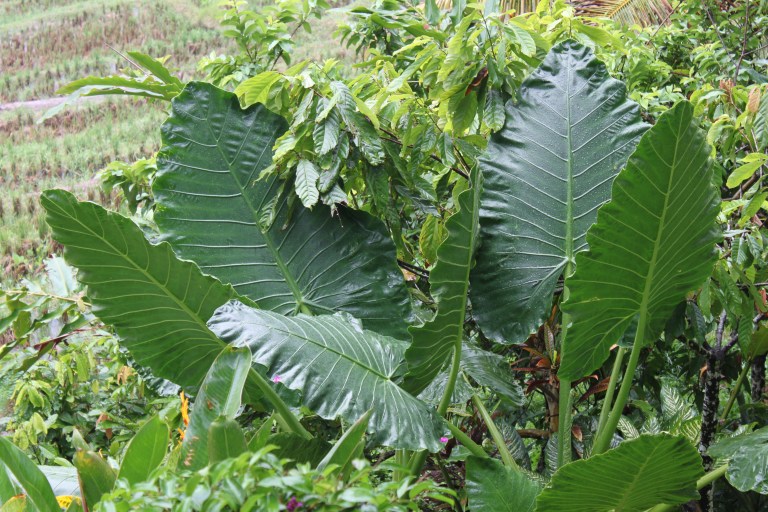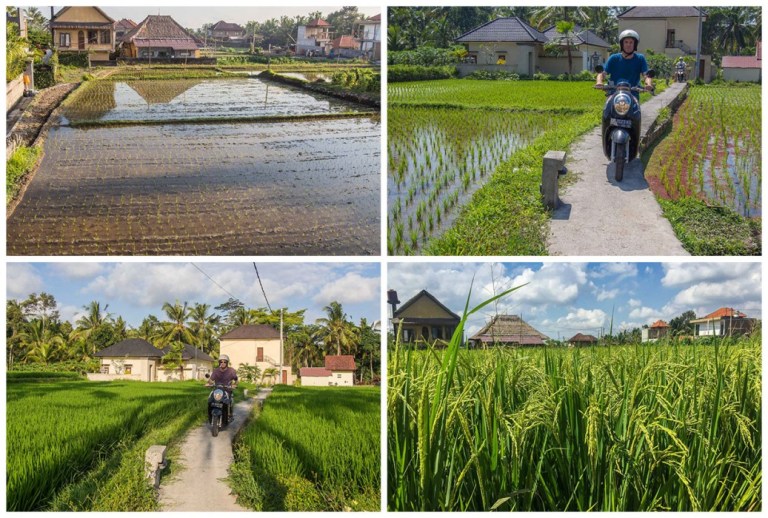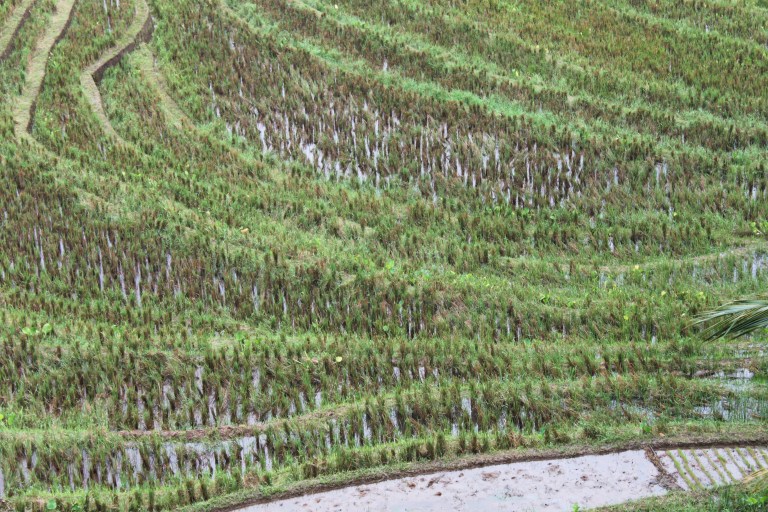The road from Tanah Lot was green.
Beyond the general atmosphere of driving in Indonesia, the intense density of green life outside our windows was one of the most striking parts of the ride. It was rainy season in Bali, and despite the ongoing El Niño pattern reducing the rain fall on this side of the Pacific, the island’s plant life was looking fairly vibrant to us. What a myriad of shapes of trees, where we only recognized palms, bamboos, and figs. Even with those, there was a surprising variety of shapes and sizes, although many of the palms looked like fluffy balls of shaggy green leaves atop a thin, pale post. Many other trees looked almost like they could be part of a young deciduous forest back home, but were simultaneously quite unidentifiable to our eyes. There were tall grasses and sections of dense brush, all of which were leafier than tends to happen in the north-eastern US states we call home.

And most strikingly different from home, the rice paddies. Large rectangular plots of land filled with a few inches of standing water and little pale green sprouts of wide-leafed grass popping out of the mud: the nursery and the infancy of rice. As we were there in January, the rice was only recently planted – and since the season’s El Niño had prevented the usual amount of rainfall, it was growing a little more slowly than usual. We got to see many of these baby plants throughout the island of Bali, as the paddies often border roads.

Now, these paddies require a certain amount of level ground, in order to the keep the plants’ feet wet enough to grow properly. This isn’t a problem on some parts of the island, but in the more mountainous areas, it has meant the development of extensive terrace landscaping, in order to create a series of flat panels of earth to flood and make into homes for the growing rice. Sometimes, they are wide, deep, and few in number, but for steeper hills, the terraces will be little deeper than the run of large steps of some grand staircase, all stacked close together. To see such rice paddies, we asked our driver on the road between Tanah Lot and the northwest of Bali to bring us through one of the more respected but off-the-beaten-track areas for rice terracing on the island: Belimbing.

And so in addition to some striking landscapes that we got to see out the window of our car as we drove through the forested mountains of Bali, we took a few short excursions once in Belimbing to see the rice paddies from closer up. Belimbing itself is a small village, a few hours’ drive from Denpasar and not highly frequented by tourists at all; rather being somewhere that travelers who have spent a lot of time traversing Bali, away from the usual tourist destinations, tend to recommend. There are accommodations and restaurants there, because just enough people from far away have heard of the beauty of its terraces, but not enough to make it over run by any stretch of the imagination. It is particularly lauded when the rice grasses are closer to full grown than when we were there, as the colors become richer and the leafy plants denser, making the stepped look of the terraces more vivid and distinctive – or at least when the sun is out and reflecting off all the layers of fields, neither of which we got to see in Belimbing.
But that’s ok, because it was still really neat to see this ancient agricultural practice with well adapted landscape architecture techniques to make the most use of the space at hand. The elegant curves of the terraces following the hillsides, stacked together like a 3D puzzle such as the Towers of Hanoi, really showed how a solution to a farming dilemma could also be beautiful, as well as practical. Moreover, the Balinese have developed symbolic and functional cooperative systems for managing such landscapes and the water required to maintain them, making them deeply interwoven into the local land, religion, social structure, economy, and food systems to such an extent that they have collectively been deemed a World Heritage Site.


Rice farming, however, is back-breaking work, at least when it is done in traditional fashion by hand as it usually is in Bali. The farmers must wear high rubber boots or go in bare-foot, spending long hours planting, weeding, and tending to their crops, while risking severe diseases from the mosquitoes that breed in the standing water of the fields. We were told by numerous people during our time in Bali that their families were rice farmers but that they had left their villages to go the city for work in tourism for a less painful, and (relatively) more lucrative life.

Our driver on this particular trip was one such man, and he told us of the long days of hard work in the fields that he had to do with his family when he was younger. He said he didn’t miss the work too much, but that he did mourn his distance from the self-sustainability of the farming life: You made hardly any money, even by Indonesian standards, from selling your grains, but that you didn’t need as much money to be satisfied, either. You could get enough variety of food and other materials from bartering with your neighbors or gathering things from the forest, and that the community would come together to take care of each other in times of need. He described how many young people would leave that life to have a more modern way of living in the city, or how families would sometimes sell their land to foreigners or hoteliers to do the same, but that they would often find themselves struggling to rebuild enough community in the city to have a balance in the long run, particularly after they became dependent on money to get by: A give and take as modernization and globalized tourism have transformed this traditional economy.


These farmlands are bordered by many types of other interesting Balinese plants, some in gardens, some wild. Among the plants growing in these dense, humid landscapes are a variety of tropical fruit-bearing trees, producing coconuts, soursops, durians, bananas, rambutans, guavas, and more. These trees, in addition to attracting humans, of course, also are a lure for giant fruit bats. These “megabats” or “flying foxes,” as a group, have lost their ability to echolocate for navigation and food-finding. As a result, they cannot live in caves like their “microbat” brethren, and instead hang to rest from bushes and trees where they can see well enough to land and take off safely. And, as it turns out, that includes bushes next to the restaurant and view-point where our driver took us to view the rice fields! He very nonchalantly pointed them out as we passed, knowing they would likely be a surprise to us.

Fruit bats all curled up to protect themselves in the rain. Look at those orange backs!
Toby and I, perhaps needless to say to those who know our usual curiosity, found these giant and mellow creatures rather fascinating and welcomed the unexpected sight. They were sleepy but awake, and didn’t seem to mind our photographs, although we definitely did not touch them.
On the way out, our driver encouraged us to look around the little shop attached to the restaurant/view-point… and it was strongly and yet indirectly implied that we should buy something there in payment for letting us onto their property to check out the rice fields and the bats. So, a bottle of water it was! Since it was so hot and humid in Bali, and yet the tap water is often unsafe to drink, it was hard to have too much bottled water, especially since we didn’t know what our next accommodation would be able to provide.
It also turned out that we didn’t know exactly where our accommodation was! We had found this place, called House of Hobbit, through Air BnB, where we got an address from the map feature on the site. However, since Google Maps doesn’t actually know where the House of Hobbit is, it apparently only gave us an approximate location… and put the map marker on a random road nearby. We found this out the hard way, after our driver had finally gotten us to the right area, despite some loud grumblings and manipulatively phrased (but probably also honest) comments about the long drive and needing to get home to his kids – he had some misunderstandings from the guy who took our info and arranged this drive about where we were heading, first thinking we were stopping in Belimbing, then thinking we were stopping in the town of Pemuteran, then finally realizing approximately where we were actually going, but not really knowing that area at all and not having a detailed map of it…
And so we got almost to the end of this particular road trip without a problem. The road that Google Maps had pointed out as the location of our next homestay turned out to be really rough, filled with rocks and bushes, narrow, with tall grasses looming on either side of the car. We actually saw several motorbikes pass us, just barely getting by, with large piles of plants on the back-racks, headed for the mouths of cows and pigs. The driver was getting increasingly uncomfortable with the way the road was bouncing around his little sedan car, and understandably so. After making a number of indirect comments about what our accommodation could possibly be like and why they would make tourists come down a road like that, he finally declared that he thought this was a road only for motorbikes and off-road vehicles, and that we should back up, find the closest village, and ask for help. Lesson: when staying in off-the-beaten-path accommodations, when possible ask them for navigational advice ahead of time to find out just how beaten your path will actually be or not. Or get your accommodation to send someone to pick you up.
We totally agreed with our driver’s suggestion to confirm if this was actually where we needed to go before we got totally stuck. After disentangling the car from this not-for-cars-road, our driver managed to find some cellphone service before we found people, which meant we could call our next host and have the two of them talk in Indonesian to figure out how to stop us being so lost. We finally found our way to the village of Pejarakan, where people knew exactly where House of Hobbit was! We had been so close, and yet the quality of the road was drastically different once we actually got to the right place. It was clearly much more of a town, and was perched at the top of a hill overlooking the sea out towards the sacred island of Menjangan. We had some unexpected and very worthwhile experiences in this area, which will be the subject of our next few posts!



Great pictures of the rice paddies and natural surroundings – I can only imagine the hours and hours of hard physical labor that went into building those beautiful terraces!!
And for those doubters of the power of evolution to adapt, just look at those bats and how the basic mammalian genetic code has evolved their arms and legs to create just the right finger nails and skin to create a flying machine that can park itself upside down to rest!
And, as usual, your writing is excellent and engaging.
Love you – Dad
LikeLike
Thank you, Dad! And well said, I totally agree about the rice paddies and the bats!
LikeLike